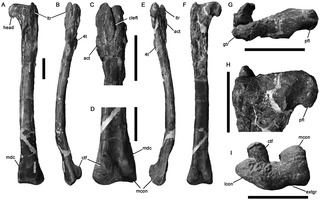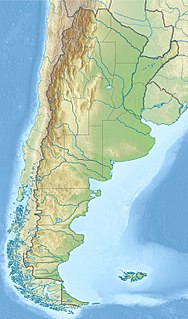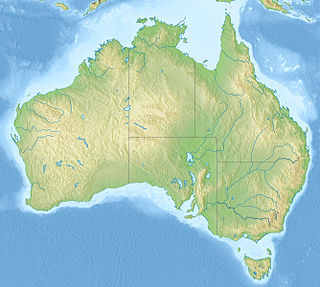
A calcium–aluminium-rich inclusion or Ca–Al-rich inclusion (CAI) is a submillimeter- to centimeter-sized light-colored calcium- and aluminium-rich inclusion found in carbonaceous chondrite meteorites. The four CAIs that have been dated using the Pb-Pb chronometer yield a weighted mean age of 4567.30 ± 0.16 Myr. As CAIs are the oldest dated solids, this age is commonly used to define the age of the Solar System.

Fukudomi was a town located in Kishima District, Saga Prefecture, Japan.

Ariake was a town located in Kishima District, Saga Prefecture, Japan.

Kishima is a district located in Saga Prefecture, Japan.

Mount Aso is the largest active volcano in Japan, and is among the largest in the world. It stands in Aso Kujū National Park in Kumamoto Prefecture, on the island of Kyushu. Its peak is 1,592 metres (5,223 ft) above sea level. Mount Aso has a fairly large caldera with a circumference of around 120 km (75 mi), although sources vary on the exact distance.
Serendipaceratops is a dubious genus of herbivorous ornithischian dinosaur from the early Cretaceous Period of Australia.

Timimus is a genus of small coelurosaurian theropod dinosaur from the Early Cretaceous of Australia. It was originally identified as an ornithomimosaur, but now it is thought to be a different kind of theropod, possibly a tyrannosauroid.

A brightest cluster galaxy (BCG) is defined as the brightest galaxy in a cluster of galaxies. BCGs include the most massive galaxies in the universe. They are generally elliptical galaxies which lie close to the geometric and kinematical center of their host galaxy cluster, hence at the bottom of the cluster potential well. They are also generally coincident with the peak of the cluster X-ray emission.

Hiroshi Ogushi is a Japanese politician and a member of the House of Representatives in the Diet. A native of Kishima District, Saga and graduate of the University of Tokyo, he joined the Ministry of Finance in 1989 and received an MBA from University of California, Los Angeles in the United States while in the ministry. Leaving the ministry in 2005, he was elected to the House of Representatives for the first time in the same year.

The Cerro Barcino Formation is a geological formation in South America whose strata span the Early Cretaceous. The top age for the formation has been estimated to be Albian. Earlier estimates placed the formation until the Campanian.

The Wonthaggi Formation is a geological formation in Victoria, Australia whose strata date back to the Early Cretaceous. It is part of the Strzelecki Group. Dinosaur remains are among the fossils that have been recovered from the formation. It is equivalent to the Eumeralla Formation.
The Beaverhill Lake Group is a geologic unit of Middle Devonian to Late Devonian age in the Western Canada Sedimentary Basin that is present in the southwestern Northwest Territories, northeastern British Columbia and Alberta. It was named by the geological staff of Imperial Oil in 1950 for Beaverhill Lake, Alberta, based on the core from a well that they had drilled southeast of the lake, near Ryley, Alberta.
Argentodites is a possible multituberculate mammal from the Cretaceous of Argentina. The single species, Argentodites coloniensis, is known from a single blade-like fourth lower premolar (p4) from the La Colonia Formation, which is mostly or entirely Maastrichtian in age. The p4 is 4.15 mm long and bears eight cusps on its upper margin and long associated ridges on both sides. The enamel consists of prisms that are completely or partly surrounded by a sheath and that are on average 6.57 μm apart. Zofia Kielan-Jaworowska, who described and named the fossil in 2007, regarded it as a multituberculate, perhaps a cimolodontan—and thus, a member of a mostly Laurasian (northern) group and an immigrant to Argentina from North America—on the basis of the shape of the tooth and features of its enamel. In 2009, however, two teams argued that Argentodites may in fact be close to or identical with Ferugliotherium, a member of the small Gondwanan (southern) group Gondwanatheria; although their relationships are disputed, gondwanatheres may themselves be multituberculates.

Kazuki Fukuchi is a former Nippon Professional Baseball outfielder.

The Bluefield Formation is a geologic formation in West Virginia. It preserves fossils dating back to the Mississippian subperiod of the Carboniferous period. Sediments of this age formed along a large marine basin lying in the region of what is now the Appalachian Plateau. The Bluefield Formation is the lowest section of the primarily siliciclastic Mauch Chunk Group, underlying the Stony Gap Sandstone Member of the Hinton Formation and overlying the limestone-rich Greenbrier Group.
Way Group is a geologic group of Lower Cretaceous age located in northern Chile. The sediments of the group deposited in Coloso Basin, a small intra-arc basin made up by a half graben. The now inactive Coloso Basin is elongated along a NNW-SSE oriented axis and has its southwestern border made up by faults.

The Santana Group is a geologic group, formerly included as the middle part of the Araripe Group, in the Araripe Basin of northeastern Brazil. The group comprises the Crato, Ipubi and Romualdo Formations and is dated to the Aptian to Albian stages of the Early Cretaceous. The formations of the group were deposited in a lacustrine to subtidal shallow marine environment in the Araripe rift basin.
This page is based on this
Wikipedia article Text is available under the
CC BY-SA 4.0 license; additional terms may apply.
Images, videos and audio are available under their respective licenses.











